Despite the little love that man is showing for the planet Earth and that every day becomes more and more palpable, with environmental catastrophes such as that of the Gulf of Mexico, Mother Nature still reserves for us some extraordinary surprises ready to be admired by those who own it. just look to do it. And this is what the scientists of the IISE, International Institute for Species Exploration, of the University of Arizona do, who also this year studied and classified the new animal and plant species discovered in 2009 by publishing the annual TopTen with the most interesting species of the planet. Which?
He is about to end up run over, his mother saves him
Despite the little love that man is showing for the planet Earth and that every day becomes more and more palpable, with environmental disasters like that of the Gulf of Mexico, Mother Nature still reserves for us some extraordinary surprises ready to be admired by those who have the right gaze to do so. And this is what the scientists of the IISE, International Institute for Species Exploration, of the University of Arizona do, who also this year have studied and classified the new animal and plant species discovered in 2009 by publishing the annual TopTen with the most interesting species on the planet. Which?
Index
Nepenthes attenboroughii
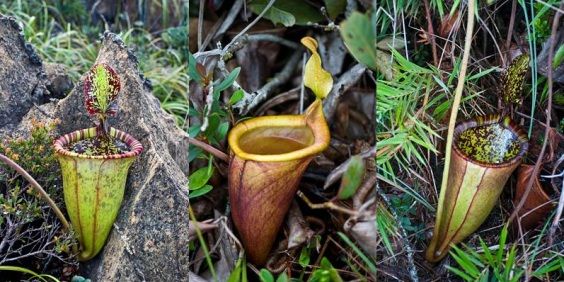
Name: Nepenthes attenboroughii
Common name: Nobody
Family: Nepenthaceae
Distribution: Philippines, Palawan Island, Mount Victoria.
How did its name come from ?: The specific epithet, "attenboroughii", is a commemorative, in honor of David Attenborough, a famous and undisputed British documentary maker and science writer. This dedication came for his 80th birthday.
Udderly Weird Yam
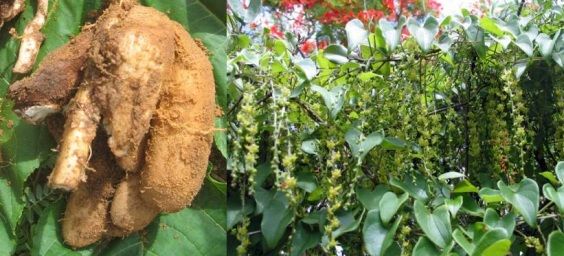
Name: Orangeana Dioscorea
Common name: Angona (also used for other potato species from northern Madagascar)
Family: Dioscoreaceae
Why in the Top 10 ?: THEOrangeana Dioscorea is a new species of edible potato present in Madagascar. The feature that makes it special is its morphology which has several lobes instead of just one, which give it an appearance vaguely reminiscent of a breast. Although recently discovered, scientists believe it to be red band, critically endangered, as it grows in protected habitats and is very collected.
Distribution: Madagascar, Antsiranana Province, Orangea Forest.
How did its name come from ?: The vulgar name Angona also applies to Dioscorea sambiranensis among other species. The epithet Orangeana was chosen as a clear reference to the distribution range of the species which is endemic to the Orangea Forest.
Worm Bomber
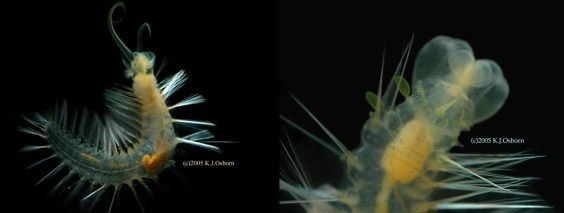
Name: Bombiviridis Swima
Common name: Green bomber
Family: Acrocirridae
Why in the Top 10 ?: This deep-sea annelid is a real bomb. This species has modified gills so as to be able to evert them outwards, creating the effect of aburst of light. This natural flash bang uses green bioluminescence creating a strong glow for a few seconds. Scientists argue that this is a defense mechanism of the animal.
Distribution: USA, California.How did its name come from ?: The name comes primarily from its ability to swim (swima). Specific epithet comes from Bombus, the Latin root meaning buzzing or buzzing from which the English word bomb derives and Viridis which in Latin means green (Bombiviridis).
Snail eats insects
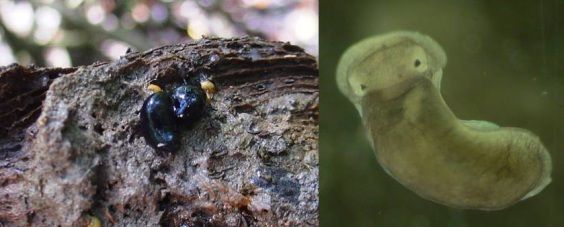
Name: ATER Aiteng
Common name: Aiteng
Family: Aitengidae
Why in the Top 10 ?: His discovery led to the discovery of a new family, that one Aitengidae. It's a sea snail which shares many of the characteristics of the Sacoglosses except for food. In fact, it is the only one to feed on insects while its peers are normally eaters of seaweed.
Distribution: Thailandia, Golfo di Thailandia, Mr. Phanang Bay.
How did its name come from ?: The name comes from Ai Theng, which is the name of one of the popular puppets typical of Thailand southern. A kind of black joker that plays in the night. The smooth Ai Theng with its large side eyes are strongly reminiscent of this newly discovered snail.
Frog fish
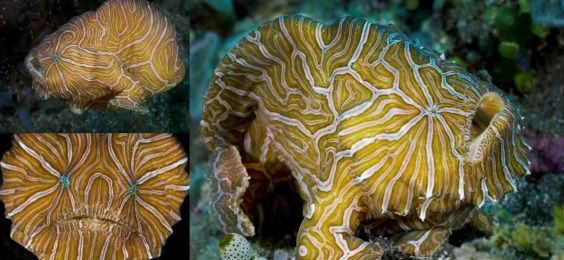
Name: psychedelics Histiophryne
Common name: frogfish Psychedelic
Family: Antennariidae
Why in the Top 10 ?: It is a very unique and unusual fish and has a highly psychedelic coloring, made of colored circles and streaks, unique in the genus of Frogfish.
Distribution: Indonesia, Provincia in Maluku, Isola in Ambon, Baia in Ambon.How did its name come from ?: Lepiteto psychedelica arises precisely from the observation of its color and from this colored pigment that creates this series of concentric rings and strips that completely cover the body including the head and fins.
Spider with the golden eye
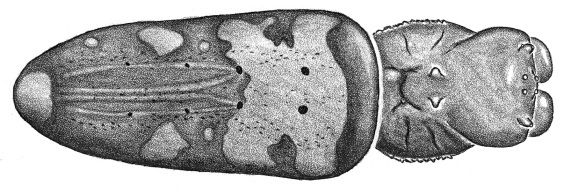
Name: Nephila komaci
Common name: golden-eyed Komac spider
Family: Nephilidae
Distribution: No precise data.
How did its name come from ?: The name of this arachnid was given by Dr. Kuntner, the scientist who discovered it, in honor of a late colleague and friend, Andrei Komac.
Small Favor
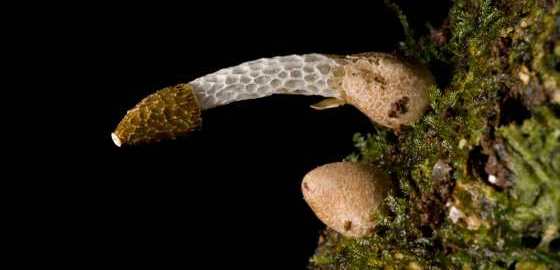
Name: drewesii Phallus
Common name: Nobody
Family: Phallaceae
Why in the Top 10 ?: This very small mushroom, which measures just five centimeters, has the characteristic of attracting a large number of insects thanks to its scent.
Distribution: Africa, Sao Tome, Obo National Park.
How did its name come from ?: The name was given in honor of Dr. Robert C. Drewes (California Academy of Sciences), who devoted many years of his life to the study of biodiversity multi-organism on the islands of São Tomé and Príncipe and in general throughout Africa.
Fang fish

Name: Dracula Danionella
Common name: minnow Dracula
Family: Cyprinidae
Why in the Top 10 ?: The males of this species have very developed canine teeth which they use in clashes with other males during the reproductive period. It is the only fish belonging to the cyprinid family to have teeth and moreover so developed.
Distribution: Myanmar, Kachin State.
How did its name come from ?: The name is inspired by Bram Stoker's novel Dracula.
Electric band knife fish
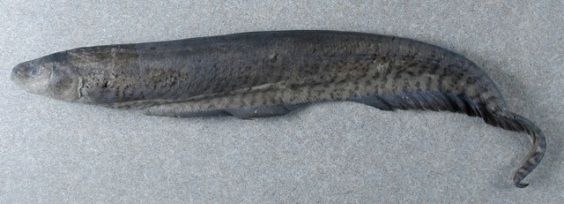
Name: Themarorum gimnoto
Common name: Knifefish banda Omar
Family: Gymnotidae
Distribution: Uruguay, Maldonado Department, Swan River basin, Willow Lagoon.
How did its name come from ?: The name was born to honor Omar and Omar Macadar Trujillo-Cenoz, both pioneers in the anatomical and physiological study of these creatures.
Sponge Killer
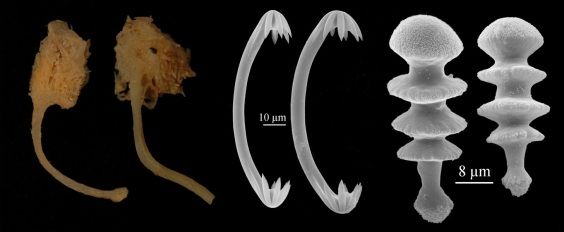
Name: Chondrocladia (Meliiderma) turbiformis
Common name: Nobody
Family: Cladorhizidae
Distribution: New Zealand, Rise Chatham, Pyre Seamount.
How did its name come from ?: The name derives from the particular shape of the spicule of this sponge, which recalls the shape of a spinning top.We just have to wait impatiently for the Top Ten of 2011, to see what nature has in store for us. And if you have a new species to report you can do it at this link
Lorenzo DeRitis


























